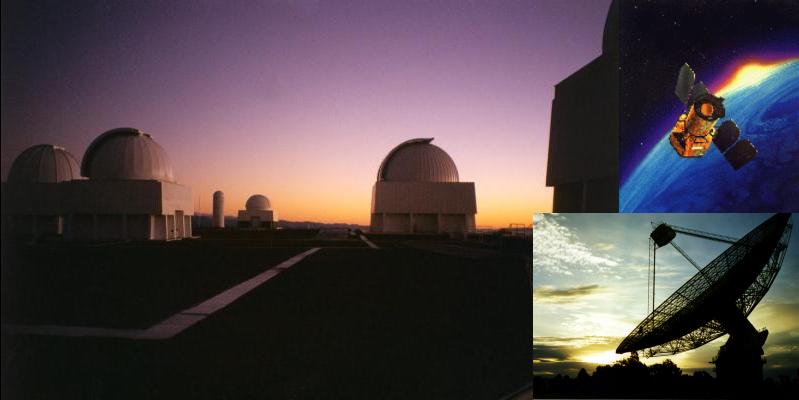Gas rich galaxies display a wide range of structures and properties, but one thing they all seem to have is some newly formed stars. These images from SINGG Release 1 (SR1) accentuate star formation in gas rich galaxies. Here we present galaxies that illustrate the wide range of properties, from giant spirals to tiny dwarfs, isolated galaxies to groups, new found companions, mergers and collisions, galaxies blowing puffs of wind, normal galaxies and rare systems, and some with down right bizarre shapes.
All images here are displayed so that stars have a cyan-blue appearance, while Hα emission appears orange-red to yellow. The Hα emission marks where the gas in the galaxies has been ionized, and is now recombining. It takes very hot O stars to ionize the gas, these have very short lifetimes (a few million years). Hence red tones in these images typically mark the location of newly formed hot stars.
Stars tend to form together - making discreet star clusters or stellar associations. Once formed, these ionize their natal gas clouds to form HII regions. In the images here, HII regions appear as compact sources which have cores that are orange to white in appearance, with a skirt of fainter diffuse Hα emission. The overall size is on the order of tens to a hundred parsecs (or a few arcsec for the galaxies shown here). Sometimes the ionized skirt extends far from the central cluster. This extended Hα emission is refered to as Diffuse Ionized Gas. In some cases DIG can be found a kiloparcsec or more from HII region cores. It is not clear what is ionizing the DIG.
Thumbnails of the images are arranged in the table below. Above each thumbnail is the name of the galaxy from the HIPASS survey, below we give more traditional optical catalog names. Click on the thumbnail image to see the full resolution image. The resultant images are at least 1200 pixels on a side. Nevertheless, they are cutouts of even larger images (1800 or more pixels on a side).
If you would like the original science quality FITS images please visit our public data portal. You can also obtain all the JPG images highlighted here (as well as four bonus spiral galaxies) packaged in a single TAR archive. The images can then be used as backgrounds, screen-savers etc.
| Big spirals | |||
|---|---|---|---|
J1018-17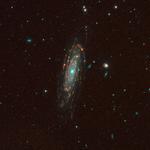 NGC3200 |
J1337-29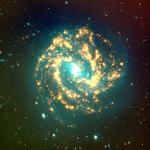 NGC5236 (M83) |
J1318-21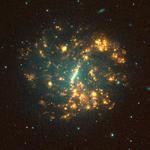 NGC5068 |
J0240-08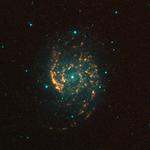 NGC1042 |
| Explanation: When one thinks of the word "galaxy" it is usually these large spiral galaxies that come to mind. The disk in these galaxies form when the gas in the system collapses. The spiral pattern is caused by a density wave in the disk which can cause enhanced star formation along the arms to make a grand design spiral. In other cases the star formation is more random to make a flocculent spiral galaxy. | |||
| Irregular and dwarf Irregular (dI) galaxies | |||
J0314-04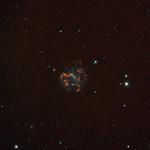 DDO32 |
J0145-43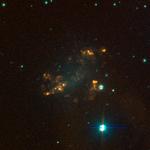 ESO245-G5 |
J0043-22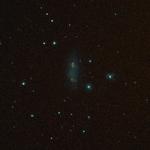 IC1574 |
J1106-14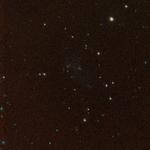 KKS2000-23 |
| Explanation: although all SR1 galaxies are observed to have some Hα emission, the Irregular and dI galaxies have some of the weakest star formation. In the most mediocre case here (J0043-22) the Hα luminosity can be accounted for by just 7 main sequence O5 stars. | |||
| Edge-on galaxies with extra-planar Hα | |||
J0256-54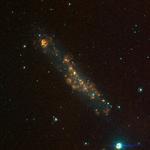 ESO154-G023 |
J2052-69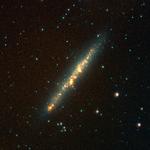 IC5052 |
J1303-17c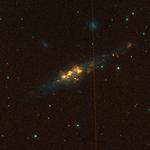 UGCA310 |
J2352-52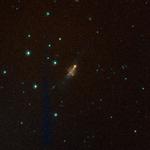 ESO149-G003 |
| Explanation: When a disk galaxy is seen edge-on, we can tell whether there is any DIG extending off of its mid-plane, as can be seen in these examples. Such extraplanar Hα probably represents interstellar gas being expelled from the disk by supernovae and stellar winds. | |||
| Windy Blue Compact Dwarves | |||
J0506-31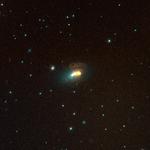 NGC1800 |
J0135-41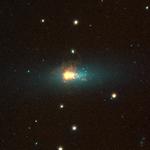 NGC625 |
J0454-53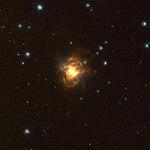 NGC1705 |
J1339-31A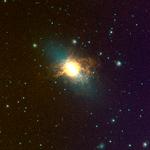 NGC5253 |
| Explanation: Galaxies with intense star formation and low mass are most able to eject their gas in a galactic wind. The Blue Compact Dwarf (BCD) galaxies meet these criteria and, like these examples, are often seen to have strong outflows. | |||
| Pairs and groups | |||
J0359-45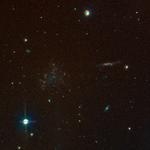 Horologium dwarf/ ESO249-G35 |
J2149-60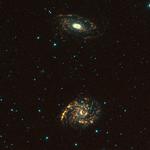 NGC7125/NGC7126/ ESOG150-18A |
J0514-61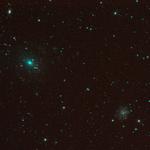 ESOG119-48/44/ 2MASS |
J0209-10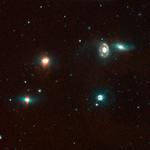 NGC839/838/835/833 (HCG16) |
| Explanation: SR1 contains nice examples of well separated pairs and groups, including these examples. If you have trouble identifying all the Hα emitting galaxies in the image, click on the HIPASS name to see a finder chart. | |||
| Interactions and collisions | |||
J0403-43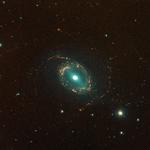 NGC1512/NGC1510 |
J0039-14a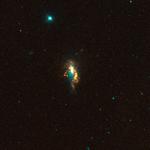 NGC178 |
J0355-42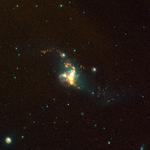 NGC1487 |
J0224-24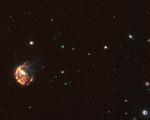 NGC922/2MASS |
| A strong interaction between a barred spiral (NGC1512) and a BCD (NGC1510). Both have starbursts, probably triggered by the interaction. Surprisingly star formation is 3X stronger in the dwarf. | This peculiar BCD has a arc of HII regions above one pole, possible tidal tails, and a minor axis flow on one side. Could it be a merging dwarf system? | A merging spiral system showing clear tidal arms, and two nuclei. | The most luminous SR1 galaxy in Hα has a "C" shape representing an almost complete collisional ring. The innoccuous dwarf which passed through the main galaxy is on the right. |
| Mother and child | |||
J0504-16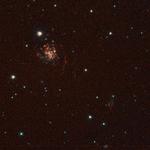 MCG-03-13-063/ (new) |
J2202-20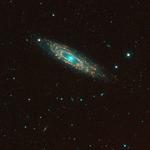 NGC7184/ APMUKKSB(J) |
J0221-05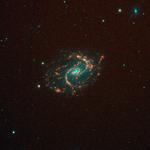 NGC895/NGC895A |
J0342-13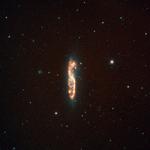 NGC1421 APMUKKSB(J) |
| Explanation: These are examples of large galaxies with very small companions. In some instances the companions were previoisly uncataloged, or not known to be related. If you don't see the companion click on the HIPASS name for a finder chart. | |||
| Odd and rare galaxies | |||
J0409-56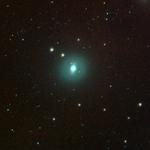 NGC1533 |
J0019-22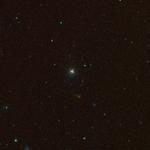 MCG-04-02-003 |
J0430-01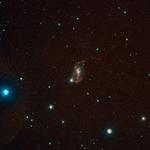 UGC3070 |
J1217+00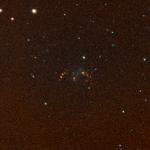 UGC7332 |
| An S0 galaxy having a few bright HII regions near its core, and a few very faint ones in the extreme outskirts of the galaxy (bottom and left sides of image). | A polar ring galaxy? This faint galaxy looks like an elliptical galaxy in the R band, but has intense star formation in its core, while faint HII regions trace an outer ring. | A galaxy shaped like a parallelogram. | This dI galaxy looks like a Game Boy console. |
We thank Lyra, Michael, Hans, Anne, Capella, Rita, Kristin, Maren,
Sandra, Uta, Esther, David, Elisabeth, Ruth, Darwin, Katrina, Matthew,
and Kiran for helping us choose the prettiest spiral galaxies
Disclaimer: This page, its contents and style, are the responsibility of the author and do not necessarily represent the views, policies or opinions of the International Center for Radio Astronomy Research or The University of Western Australia.
Maintainer: Ed Elson (ed.elson -at- icrar.org)
This site is written using XHTML
1.1 guidelines, and uses CSS. To view this page properly, get the
latest version browser for your computer.
Last modified: March 2011
